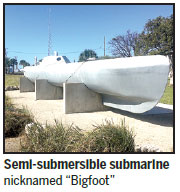Colombian cocaine smugglers hide beneath the waves
For the US Coast Guard at least, Bigfoot is real - and is proudly on display in Key West, Florida, on the southernmost tip of the United States.
The hulking monster in question, a sasquatch of the sea, is a 15-meter semi-submersible boat built by drug smugglers in the mangroves of Colombia to sneak tons of cocaine to the US.
Though it looks like a scaled-up bathtub toy, the gray vessel was built for stealth and marks a milestone in the cat-and-mouse game played by drug cartels and the police.
"At first, there were just grainy photos. No one believed it was real," an intelligence analyst said.
Reports of "narco-subs" first surfaced in the mid 1990s but it wasn't until 2005 that US authorities started getting specific intel on one of the craft, when photographs emerged of a strange-looking vessel bobbing low on the water.
True submarines
Those first images were hard to make out, so when US authorities intercepted the boat in 2006, it quickly won its Bigfoot nickname.

Though Bigfoot is not a true submarine, most of its bulk is hidden below the water, making it harder to spot visually and with radar. When intercepted, its four-man crew had packed 4.2 tons of the drug into the boat's bulbous bow.
Smugglers still mainly use highly maneuverable, open-hulled speed boats called "go-fasts" to zip their cargo across the eastern Pacific or Caribbean to Central America or Mexico, but in the decade since Bigfoot's seizure they have refined their marine know-how and are now successfully building true submarines.
One such vessel captured in Ecuador was 26.5-meter long and ran on a diesel engine, but could go completely underwater for short spells, when it would be powered by batteries, the analyst said.
Not content with building fully submersible drug boats, the analyst said cartels are likely working on the next step in the smuggling arms race: autonomous underwater vehicles that don't need a crew, are guided by GPS and can stay underwater for almost their entire routes.
"That's the nightmare scenario," he said.
The captain of such vessels can earn as much as $75,000 for a single run. Money is plentiful for the cartels - the boats themselves can cost about $1 million to build, but that is just a tiny fraction of their cargo's value.


















